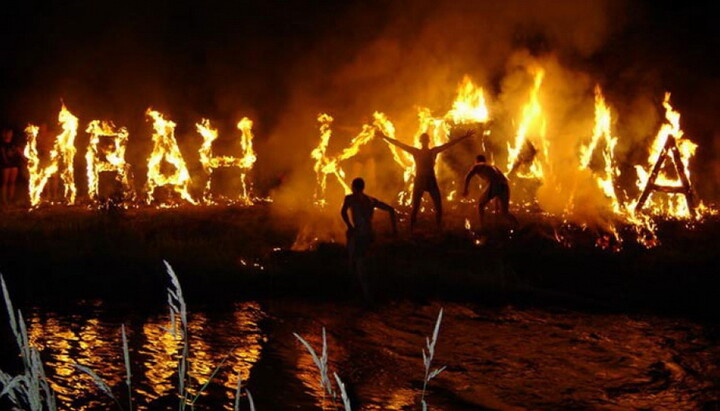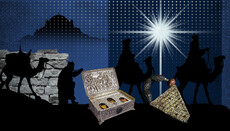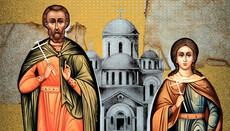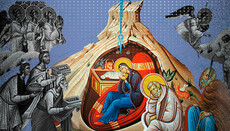Who is this Kupala, or Pagans among us

On July 7, the Church commemorates the Nativity of John the Forerunner. Yet in the media and across various internet resources, instead of the feast’s Church character, we see stories about its “pagan” roots.
As the day of the Prophet and Baptist John’s Nativity approaches, the average citizen is bombarded from every direction with claims that on this day there is a cosmic struggle between light and darkness in which darkness triumphs, since daylight begins to wane and nighttime grows longer. The feast is presented not as honoring God’s prophet John, but as being dedicated to some pagan “deity” called Kupala. This is packaged as a “return to the faith of our ancestors” and promoted as the only form of religion supposedly suitable for Ukrainians. But is this really so?
New Paganism and Old Paganism
Neopaganism is a recent phenomenon. It arose only in the 20th century and, in fact, has little to do with genuine ancient paganism that existed before the Slavs became Christians. Almost nothing is known about the paganism of those times. Neopagans base their beliefs on pre-Christian, folkloric, and ethnographic sources. But most often, these beliefs are so vague and eclectic that they are practically impossible to define precisely.
Many modern experts consider neopaganism a variant of the “New Age” movement, whose adherents try to fuse all religions into a single “new era” faith meant to replace Christianity, Islam, Judaism, Buddhism, and so on. What does that have to do with neopaganism? It has absorbed many elements from other religions. But precisely because of that, it cannot claim to be a “traditional belief” at all; rather, it is a syncretic cult “groomed” for the modern consumer. To understand the difference between traditional pagan culture and its modern variant, just look at “ungroomed” shamanism and everything becomes clear.
Attempts to present paganism as a religion of “love” for humanity and nature have nothing to do with reality.
Modern pagans speak of their “tolerance” and “respect” for other cultures and religions, accusing Christians of “intolerance” toward dissenters. Yet they carefully gloss over the fact that the “old” pagans were anything but tolerant, killing Christians by the hundreds and thousands simply for being Christian. The idea of paganism as a religion of “love” for people and nature has nothing to do with the truth. Because paganism includes human sacrifice, temple prostitution, and the cult of sexual immorality in general. In other words, it is a religion literally drenched in blood—not all those pretty “wreaths” and bonfire-jumping rituals.
Why has neopaganism become so popular lately? If you dig deep enough, you can conclude that the main goal of neopaganism is the fight against Christianity in general and Orthodoxy in particular. For example, Russian neopagans insist on a ritual of “de-baptism,” in which a person renounces Christ and the Church. It’s likely that something similar is happening in Ukraine as well.
So we should not be surprised that neopaganism receives such open support both in the media and among those who call themselves intellectuals. The “new era” demands a new religion, and Christianity—with its Crucified God, the Gospel, and its sacraments—clearly doesn’t fit.
Who or what is “Kupala” and where did it come from?
In the 4th century, after several fairly peaceful years for Christians and the Church, the Roman throne was taken by Emperor Julian, who became known as “the Apostate.”
This man was a contemporary of St. Gregory the Theologian and St. Basil the Great, and studied with them at the famous University of Athens. Though he was raised Christian, he became a pagan and, in 361, almost immediately after ascending the throne, launched a persecution against the Church. Interestingly, in trying to revive the dying paganism, Julian couldn’t entirely abandon what Christianity had given him. He tried to weave into his version of paganism those aspects he found useful in Christianity.
For example, following the Church’s model, Julian established hospices, distributed alms to the poor, and tried to create something like monasteries for pagans. All of this was alien and bizarre to pagans, and in the end, Julian’s efforts failed, dying with him.
Something similar is happening today.
Neopagans, who have grown up inside a Christian culture, cannot entirely abandon it. No matter how they try, their ideology inevitably parasitizes on faith in the Crucified One and constantly defines itself in opposition to it. Neopaganism is not a self-standing phenomenon but a game—a mimicry of what is imagined to be paganism. It’s like an attempt to reenact a historical event: there are costumes but no reality.
Neopaganism is not a self-standing phenomenon but a game—a mimicry of what is imagined to be paganism.
And so with “Ivan Kupala” we are being deceived, offered a substitute in place of the Church’s teachings and traditions—a concoction of so-called “native faith,” Christian elements, and pseudo-folk “customs.”
For example, neopagans claim that the word “kupala” appears already in the 11th or 12th century and comes from the word “to bathe” (allegedly because John the Baptist “bathed” Christ). But as usual, they don’t cite any sources. Meanwhile, the Soviet historian B. Rybakov argued that “kupala” has nothing to do with bathing but comes from the Old Slavic root “kup,” meaning “together,” as in “vkupe” or “kupno” (“together, jointly”). This indicates that ancient paganism knew no god named “Kupala,” and modern paganism simply personified the summer solstice celebration, inventing its “customs” and “rituals” out of thin air.
However “pretty” and seemingly harmless this “holiday” may appear to our fellow citizens, a Christian cannot participate in it. Paganism—ancient or modern, pretty or not—is always a rejection of Christ. Even a simple fondness for such things can inflict deep spiritual harm.
All those wreaths, bonfires, and jumps over them are not as innocent as they seem at first glance. The jumping had a ritual character, signifying not only the “purification” of the one who leaped over the fire but also a sacrifice to the “god” in the person of those who could not jump over it. This is not just fun or “folk tradition” but participation in sacrifices to idols, which is explicitly forbidden to Christians by Scripture and the canons of the Church.
So what?
Our people and our state were shaped under the influence of Christianity, not the writings of Lev Sylenko. Prince Vladimir managed to unite the scattered Slavic tribes by offering them Christ, not Yarilo; the Gospel, not the “Native Ukrainian Faith.” Make no mistake—if in 988 the inhabitants of Kyiv had not stepped into the waters of the Pochayna River, a tributary of the Dnipro, for baptism, there would be no Kyivan Rus, no Ukraine today.
The current attempts to restore paganism are attempts to destroy everything built under the influence of the Savior’s preaching. Our culture, our values, traditions, and rituals all grew from the Eucharist of the Gospel. The evidence for this is abundant. But there are virtually no facts indicating any significant influence of paganism on the mentality of our people.
Of course, superstitions or certain pagan elements have always existed and continue to exist in the Slavic consciousness, but they never had the main role in shaping our worldview. They only point to the people’s insufficient education—since it’s always easier to believe in nonexistent “gods” than in the real God. After all, those who do not exist cannot demand anything from a person, unlike the One who forbids killing, fornication, and theft.
So the question of a pagan “revival” is really a moral or sometimes political issue—but not a historical one. Paganism is convenient for those who don’t want to change their lives and repent of their sins. But that’s not about us, is it?











